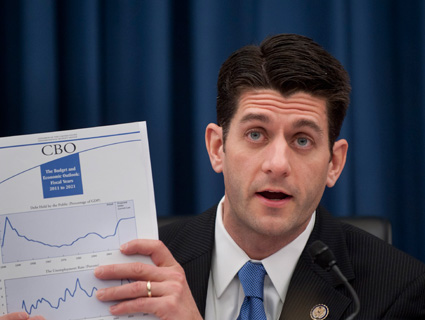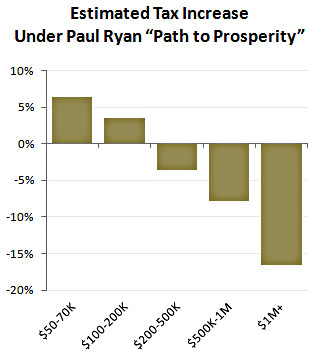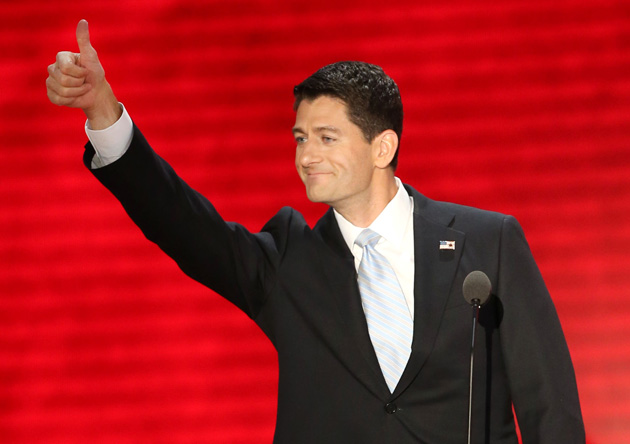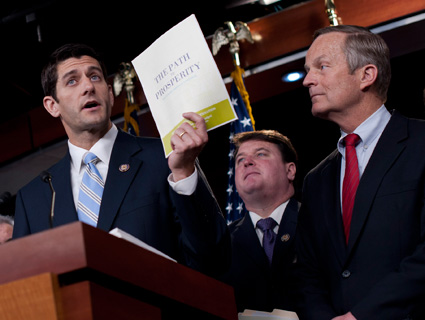
Pete Marovich/Zuma
It’s a struggle to truly explain Paul Ryan. He seems so reasonable. Why, in his speech on Wednesday, he told his audience about all the tough choices ahead but then added, “We have responsibilities, one to another—we do not each face the world alone. And the greatest of all responsibilities is that of the strong to protect the weak.” How could you dislike a Republican who says stuff like that?
It’s hard. And it’s hard to convince people that this is, basically, an elaborate and finely honed act. After all, we’re not used to politicians getting up on a stage and just flatly hustling us. We give them the benefit of the doubt, especially when they speak in sober tones and make a point of sorrowfully acknowledging how tough things are for everyone.
Nonetheless, an elaborate act is what this is. You see, Paul Ryan prides himself on being a numbers guy, and his vision for America can best be seen in his long-term budget plan. Here are the two most important numbers, as calculated by the Congressional Budget Office from Ryan’s own plan:
- Medicaid and the Children’s Health Insurance Program (CHIP): from 2 percent of GDP in 2011 to 1.25 percent in 2030 and 1 percent in 2050
- Other mandatory spending and all discretionary spending: from 12.5 percent of GDP in 2011 to 5.75 percent in 2030 and 3.75 percent in 2050.
Take a close look at that. Ryan wants to cut Medicaid and children’s health care by half. These are not especially generous programs in the first place, but in his long-term vision he wants them cut in half.
But it gets worse: He wants to cut all other spending—aside from Social Security and Medicare—by 70 percent. And even that understates things. He’s made it plain that he doesn’t want to see substantial cuts in the defense budget, which means that the domestic  budget would probably have to go down to something like 1.5 percent of GDP. That’s a cut of 80 percent or so and it affects everything. It affects prisons, food assistance, education, the FBI, assistance to the needy, courts, child nutrition, drug abuse counseling, FEMA, rape prevention, autism programs, housing, border control, student loans, roads and bridges, Head Start, college scholarships, unemployment insurance, and job training. Everything. Most of these programs would simply disappear, and the ones that remained would be shriveled and nearly useless.
budget would probably have to go down to something like 1.5 percent of GDP. That’s a cut of 80 percent or so and it affects everything. It affects prisons, food assistance, education, the FBI, assistance to the needy, courts, child nutrition, drug abuse counseling, FEMA, rape prevention, autism programs, housing, border control, student loans, roads and bridges, Head Start, college scholarships, unemployment insurance, and job training. Everything. Most of these programs would simply disappear, and the ones that remained would be shriveled and nearly useless.
Nor is that all. Despite his professed concern over the deficit, Ryan also want to cut taxes on America’s richest families. The Joint Economic Committee took a look at Ryan’s tax plan and concluded that it would most likely raise taxes on the poor and the middle classes and cut taxes on the wealthy.
Let this sink in. This is Paul Ryan’s vision for America. This is what Ryan means by “protecting the weak.” This is the core of Ryan’s tough choices: He wants to cut taxes on the wealthy and cut spending on the poor.
In fact, for all practical purposes he’d like to see most spending on the poor go away completely. But how do you get that across? It sounds so shrill, so hackish. And Paul Ryan seems like such a nice, earnest young man. Surely this isn’t what he really proposes?
But it is. There’s nothing shrill here, just the plain facts of Ryan’s plan. This is Paul Ryan’s vision for America.













